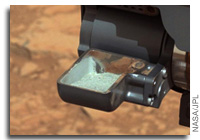Testing for Mars Organics
 CuriousMars: Rover Poised to Test For Organics Where Habitability Potential is High, SpaceRef
CuriousMars: Rover Poised to Test For Organics Where Habitability Potential is High, SpaceRef
“The Mars rover Curiosity’s team is beginning to amass enough diverse science data to actively consider whether the area around its first drilling site was potentially habitable.
At the same time the science team is readying the rover’s most powerful instruments to search for organic carbon and minerals supportive to life in its first sample of gray powdered subsurface rock.”









From the SpaceRef article:
“The finding of gray colored internal rock material and gray rocks once their red surface veneer has been brushed off by the Dust Removal Tool is a major find to scientists.“
It appears from the photos that this gray drill sample material is sitting exposed to the Martian atmosphere and whatever may be blowing by. The Martian atmosphere is very thin, but still thick enough to have dust and other particulate matter blowing into the sample and contaminating it or chemically reacting with it. And I wonder about exposure to the atmosphere itself, since the sample is free to chemically react with the carbon dioxide, as well as the trace amounts of nitrogen, oxygen and water, to create other (possibly acidic) molecules, and they will not be able to determine whether these molecules were in the drill sample or were create afterward. Is sample contamination a possible problem, or am I missing something?
The rock appears relatively permeable and this close to the surface any chemical reaction with atmospheric gasses would have occurred many years ago. The red coating is not the result of a chemical reaction with the mudstone but rather of a different material blown over it as a dust.
“any chemical reaction with atmospheric gasses would have occurred many years ago.“
I accept that statement except for the word “any.” Both because part the drilled sample has been withdrawn from within the rock, and because the withdrawn material is now powdered instead of solid, I can envisions reactions taking place in addition to any that may have happened previously. (Powdered material is often more reactive than the same material as a solid because of the greatly increased amount of surface area on which reactions can occur.)
When the rock was being formed, the material which is now part of the drilled sample may have existed in different atmospheric environments from what exists today, affecting its chemical composition, but not in the way that exposure to the atmosphere today might cause today.
Aside from all that, if, as you’ve indicated, the “red coating is not the result of a chemical reaction with the mudstone but rather of a different material blown over it as a dust,” then the sample is a combination of what was drilled and this blown over dust, so how is the experiment to know what was exclusively from the drilled sample? If nothing else, the red dust would appear to have contaminated the sample simply because the sample was left exposed to the atmosphere. This seems like too simple a situation to have been missed by the designers, so I’m assuming that there is more to it than what we’re being told in the press releases. How does MSL discern between drilled sample material and dust blown onto it after drilling?
The drill collects sample during the drilling process; it is stored inside the drill bit assembly and transferred into the CHIMRA unit for processing and delivery to SAM and Chemin. Whatever is leftover on the rock that we see in the pictures is….leftovers. The samples that will be chemically analysed are already protected inside the sampling system.
There are questions about how the flat rocks in the area formed. They say they are mudstone. I think when mud dries it cracks and forms patterns as seen there. There was a final dry out and the cracks were filled with other material. The mud was buried and formed stone. Sometime later it was uncovered.
This title is so misleading – “..where habitability potential is high”. More like “where habitability potential may have been high about 3 billion years ago”. It is so dishonest to talk about organics – implying life – on Mars in a fashion that suggests we are going to find something that wiggles on the surface. When the most optimistic is some form of slime mould – the sort of thing that was alive on Earth 3 billion years ago. All very interesting – but not what the public is being led to believe by the hype about this digging in the mud on Mars.
Now in the oceans of Europa, on the other hand, you really might find something that wiggles……